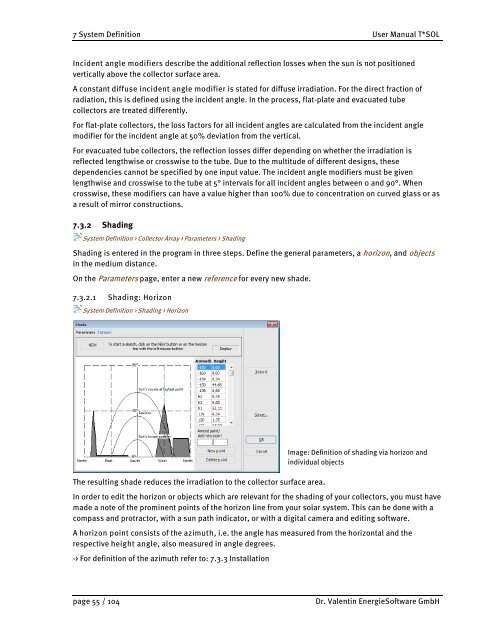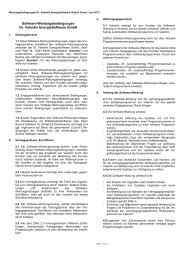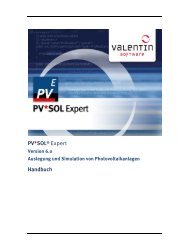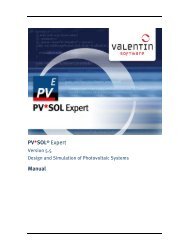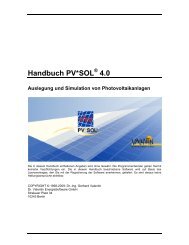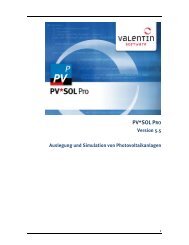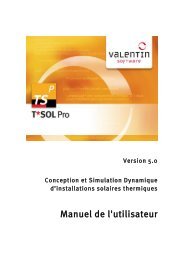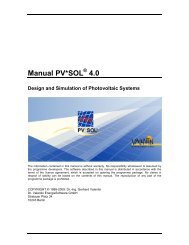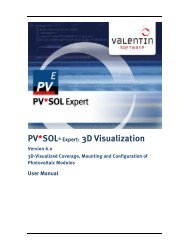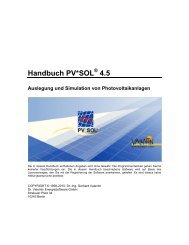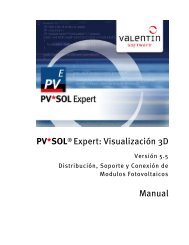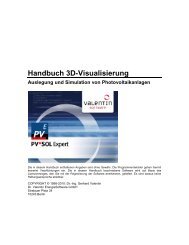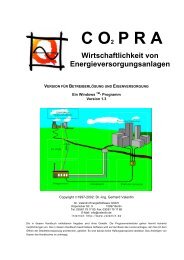Manual T*SOL basic 5.0 - Valentin Software
Manual T*SOL basic 5.0 - Valentin Software
Manual T*SOL basic 5.0 - Valentin Software
You also want an ePaper? Increase the reach of your titles
YUMPU automatically turns print PDFs into web optimized ePapers that Google loves.
7 System Definition User <strong>Manual</strong> <strong>T*SOL</strong><br />
Incident angle modifiers describe the additional reflection losses when the sun is not positioned<br />
vertically above the collector surface area.<br />
A constant diffuse incident angle modifier is stated for diffuse irradiation. For the direct fraction of<br />
radiation, this is defined using the incident angle. In the process, flat-plate and evacuated tube<br />
collectors are treated differently.<br />
For flat-plate collectors, the loss factors for all incident angles are calculated from the incident angle<br />
modifier for the incident angle at 50% deviation from the vertical.<br />
For evacuated tube collectors, the reflection losses differ depending on whether the irradiation is<br />
reflected lengthwise or crosswise to the tube. Due to the multitude of different designs, these<br />
dependencies cannot be specified by one input value. The incident angle modifiers must be given<br />
lengthwise and crosswise to the tube at 5° intervals for all incident angles between 0 and 90°. When<br />
crosswise, these modifiers can have a value higher than 100% due to concentration on curved glass or as<br />
a result of mirror constructions.<br />
7.3.2 Shading<br />
System Definition > Collector Array > Parameters > Shading<br />
Shading is entered in the program in three steps. Define the general parameters, a horizon, and objects<br />
in the medium distance.<br />
On the Parameters page, enter a new reference for every new shade.<br />
7.3.2.1 Shading: Horizon<br />
System Definition > Shading > Horizon<br />
The resulting shade reduces the irradiation to the collector surface area.<br />
Image: Definition of shading via horizon and<br />
individual objects<br />
In order to edit the horizon or objects which are relevant for the shading of your collectors, you must have<br />
made a note of the prominent points of the horizon line from your solar system. This can be done with a<br />
compass and protractor, with a sun path indicator, or with a digital camera and editing software.<br />
A horizon point consists of the azimuth, i.e. the angle has measured from the horizontal and the<br />
respective height angle, also measured in angle degrees.<br />
-> For definition of the azimuth refer to: 7.3.3 Installation<br />
page 55 / 104 Dr. <strong>Valentin</strong> Energie<strong>Software</strong> GmbH


